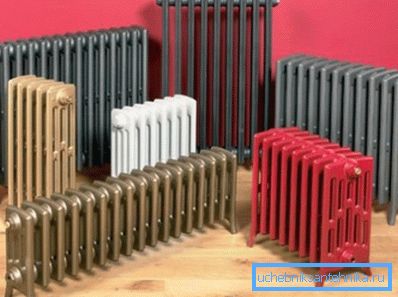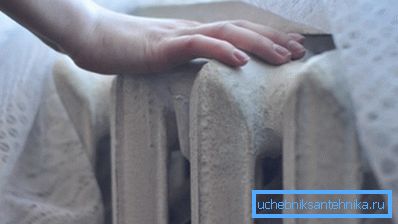Cast iron heating radiators: technical characteristics and
On the modern construction market there is a huge number of different batteries that are used to design the climate networks of both private houses and city apartments. In the latter case, the most appropriate is the use of heaters made of cast iron, since it is he who is a model of strength and durability.

Product design
Batteries that are the subject of today's article have been known in the construction industry for more than a century. During this time, the technical characteristics of cast-iron radiators of heating underwent various changes, but now in some respects they leave far behind various innovative designs made of aluminum, steel or copper.
Each cast iron battery is composed of separate sections. Radiators from gray cast iron are produced by casting into preformed molds. To connect the elements together, use special nipples. The seams are protected with rubber gaskets and sealed to prevent leaks.
Sections in products can be of two types:
- with one channel;
- with two channels.

The pig-iron heating radiator can have various geometrical dimensions. As a rule, their height is constant and ranges from 30 to 50 cm, and the width depends on the number of mounted sections of the battery.
The number of the latter is selected based on the following parameters:
- volume of heated room;
- thickness of external walls and type of heater used;
- the number of window openings and installed window frames.
Note! When arranging a heating system with cast iron batteries, depth must also be taken into account. It varies from 50 to 150 cm and affects the pipe liner, as well as the type of wall brackets used.

Heating elements can be fixed on the wall (for this purpose, special hooks are used) or be installed on the floor (in this case, legs will be needed). The instructions for their installation stipulate that small gaps (from 5 to 15 cm) should be left between the structural elements of the building and the edges of the batteries so that air can circulate normally around the radiator.
Features of use
The advantages of cast iron radiators
The fact that the described batteries, despite their advanced age, is still used today, already speaks in favor of these products.
Nevertheless, we list the main advantages of cast iron radiators:
- A possibility of use with any heat carrier. If the house has an autonomous heating system, then the quality of the liquid can be monitored. But the water that comes from the central boiler house often contains many chemicals that negatively affect certain materials. This does not apply to cast iron. It is completely chemically neutral. In addition, even the abrasive particles in the water (sand, metal, and so on) will not cause significant damage to the thick walls of the battery. As well as draining the coolant from the pipes at the end of the heating season.

- Strength. Cast iron batteries, due to their physical properties and wall thickness, can withstand the high coolant pressure characteristic of centralized heating systems (especially in high-rise buildings). However, hydraulic shocks are contraindicated in it; therefore, it is advisable to install conical control valves at the inlet nozzles, with which you can fill the batteries gradually, avoiding explosive pressure rises.
- Long service life. In this parameter, the cast iron is the champion. If you perform maintenance on the batteries in time: flush them out, replace the rubber gaskets that seal the intersection seams and protect the batteries from water hammer, they will last at least 50 years.

Note! In some old houses there are still cast-iron radiators cast at the beginning of the last century. They continue to successfully perform their functions, providing owners with warmth.
- Small cost. Cast iron is more expensive than steel batteries for home heating, but much cheaper than bimetallic radiators. Therefore, if your apartment is connected to central heating and the question of saving for you is not the last place, there is no better option than a cast iron battery.
Cons of cast iron batteries
Naturally, like any other product, cast iron radiators are not without flaws.
Let us dwell on the most important of them:
- Prolonged heating Unlike aluminum or steel, cast iron heats up for a very long time. Only after a few hours after starting the heating system will you feel the temperature increase in the room. However, this drawback sometimes turns into a plus: in case of accidents of heating pipelines, cast iron will give up the accumulated heat for a long time, without making you freeze.
- Slow heat transfer. Continuing to compare cast iron radiators with aluminum, it should be noted that at the same temperature of the liquid and the same area of the heat exchanger, the cast iron gives 50-60 watts less energy.

In addition, these batteries heat the room only by the wave method. The absence of a special form heat exchanger does not allow organizing the convection movement of air masses, which greatly affects the efficiency of the equipment.
On the other hand, heating not only the air, but also the objects in the room, cast iron products work more efficiently and do not pick up dust.
- Great weight. One section of the radiator weighs about 7 kg. Accordingly, the mass of the finished battery is such that it will be impossible to install it yourself. We'll have to turn to the help of a partner. Also, because of the large mass, you need to use durable brackets, because they will have to keep not only the battery, but also the water in it.
- Unattractive appearance. With this statement it is possible to argue. If the previously released batteries were not attractive, then the design of modern models quite naturally complements the interior of the room. In addition, you can purchase designer versions of batteries that are true works of art.

Conclusion
The analysis of the technical characteristics of cast iron batteries suggests that they are almost the only option for installing a heating network in an apartment with a centralized flow of heat carrier. Of course, you can install bimetallic radiators, however, their price is much higher.
But as for autonomous climate systems, the situation is completely different. You can learn more about this from the video offered to your attention.